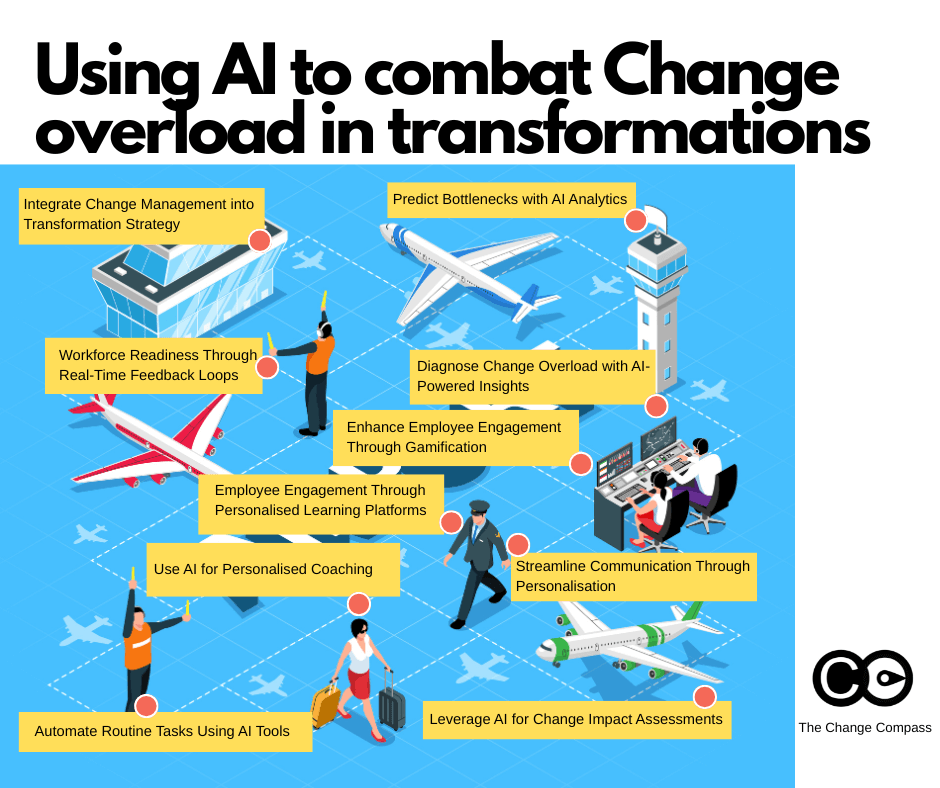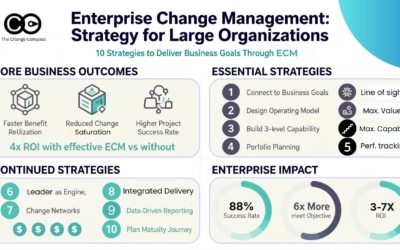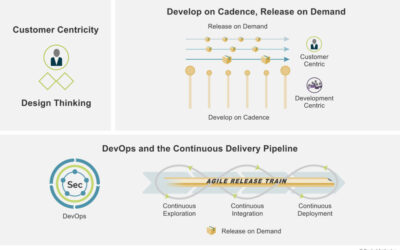Organisational transformations are essential for staying competitive in today’s fast-paced world, but they often come with challenges that can derail progress. One of the most pressing issues is change overload—when employees and stakeholders are overwhelmed by the sheer volume or pace of changes being implemented. This can lead to burnout, disengagement, resistance, and ultimately, failure to achieve transformation goals.
Artificial intelligence (AI) offers a powerful solution to combat change overload. By leveraging AI tools and strategies, organisations can streamline processes, personalise communication, optimise workflows, and make data-driven decisions that reduce stress and improve adoption rates. This guide provides actionable steps to harness AI effectively in managing large-scale transformations while preventing change fatigue.
1. Diagnose Change Overload with AI-Powered Insights
Before addressing change overload, you need to identify where it exists and how it impacts your organisation. AI-powered analytics tools can provide real-time data on employee sentiment, workload distribution, and engagement levels—helping you pinpoint areas of concern before they escalate.
How to Apply This:
- Use Sentiment Analysis Tools: Platforms like Microsoft Viva Insights or Qualtrics EmployeeXM can analyse employee feedback from surveys, emails, or chat platforms to detect patterns of stress or disengagement. For example:
- If sentiment analysis reveals a spike in negative feedback during a specific project phase, it may indicate that employees are overwhelmed by unclear communication or unrealistic deadlines.
- Monitor Workload Distribution: Tools such as Workday or Asana’s workload management feature can highlight individuals or teams carrying disproportionate workloads. This allows leaders to redistribute tasks more equitably.
- Track Change Saturation Metrics: Use metrics like the number of concurrent projects per team or the average time spent on change-related activities per week may be a start. AI dashboards can automatically calculate these metrics and flag when thresholds are exceeded.
- Visualise Change Saturation: Tools such as The Change Compass can help to easily capture change impacts across initiatives and turn these into data visualisation to support decision making. Embedded AI tools help to interpret the data and call out key risk areas and recommendations.
🔍 Example: A retail organisation undergoing digital transformation used AI sentiment analysis to discover that frontline employees felt excluded from decision-making processes. Leaders adjusted their communication approach to involve key frontline change champions which improved morale and reduced resistance.
2. Streamline Communication Through Personalisation
One-size-fits-all communication often adds to change fatigue by overwhelming employees with ineffective or irrelevant information. AI can help tailor messages based on individual roles, preferences, and needs—ensuring that employees only receive what’s most relevant to them.
How to Apply This:
- Leverage Natural Language Processing (NLP): Tools like IBM Watson can analyse employee communication styles and suggest tone adjustments for clearer messaging.
- Segment Audiences Automatically: Use platforms like Poppulo or Dynamic Signal to categorise employees by role, department, or location and deliver targeted updates accordingly. For instance:
- IT teams might receive detailed technical updates about new systems being implemented, while frontline staff get simplified instructions on how the changes will impact their day-to-day tasks.
- Automate Feedback Loops: Chatbots powered by AI (e.g., Tidio or Drift) can collect ongoing feedback from employees about the clarity and usefulness of communications during transformation initiatives.
💡 Pro Tip: Combine AI-driven personalisation with human oversight to ensure messages remain empathetic and aligned with organisational culture.
3. Predict Bottlenecks with AI Analytics
One of AI’s greatest strengths is its ability to analyse historical data and predict future outcomes—a capability that’s invaluable for managing change timelines and resource allocation effectively. Predictive analytics can help you anticipate bottlenecks before they occur and adjust your strategy in real time. For example, there could be cyclical periods of the year where the change volume tends to be higher. From our research at The Change Compass, we’ve seen that across different industries, October-November, and February-March tend to be high change volume periods.
How to Apply This:
- Forecast Employee Capacity: If you already have the data you can use tools like Tableau or Power BI to predict when teams will be overstretched based on upcoming project timelines and historical workload data. Alternatively, utilise The Change Compass’ forecasting capabilities to predict trends.
- Identify High-Risk Areas: Predictive models can flag departments or teams likely to experience resistance based on past behaviours or current engagement levels.
- Scenario Planning: Use AI simulations (such as those offered by AnyLogic) to test different implementation strategies for your transformation initiative. The Change Compass also has a scenario planning feature to help you model changes before making the decision.
📊 Example: A financial services firm used predictive analytics during its digital transformation to identify that Q4 was historically the busiest period for its customer service team. By rescheduling non-critical training sessions for later Q1, they reduced employee stress and maintained service quality.

4. Enhance Employee Engagement Through Personalised Learning Platforms
Engaged employees are more likely to embrace change rather than resist it. AI-powered learning platforms offer personalised training pathways that equip employees with the skills they need for new roles or technologies introduced during transformation.
How to Apply This:
- Create Adaptive Learning Journeys: Platforms like Degreed or EdCast use AI algorithms to recommend training modules based on an employee’s current skill set and career aspirations.
- Gamify Learning Experiences: Incorporate gamification elements such as badges or leaderboards into your training programs using tools like Kahoot! or Quizizz.
- Monitor Training Effectiveness: Use analytics within learning management systems (LMS) like Cornerstone OnDemand to track completion rates, quiz scores, and time spent on modules.
🎯 Action Step: Pair training initiatives with clear career progression opportunities tied directly to the transformation goals—for example, offering certifications for mastering new software systems being implemented.
5. Automate Routine Tasks Using AI Tools
Repetitive tasks drain employees’ energy and time—resources that could be better spent on strategic initiatives during transformations. Automation powered by AI can alleviate this burden by handling routine tasks efficiently. This not only reduces workload but also empowers employees to focus on higher-value activities that drive transformation success.
Note that this approach is assuming the organisation has the appetite to leverage AI and automation to reduce workload.
How to Apply This:
- Automate Administrative Tasks: Tools like UiPath or Zapier can automate workflows such as data entry, meeting scheduling, or report generation. For example:
- Automating the creation of weekly project status reports allows project managers to spend more time addressing risks and engaging with stakeholders.
- Streamline Onboarding Processes: Implement chatbots like Leena AI or Talla that guide employees through onboarding steps during organisational changes. These tools can answer FAQs, provide training schedules, and even send reminders for task completion.
- Enable Self-Service Options: Deploy virtual assistants (e.g., Google Dialogflow) that allow employees to access FAQs about new policies, systems, or procedures without waiting for human support.
💡 Pro Tip: When automating tasks, ensure transparency with employees about what is being automated and why. This helps build trust and prevents fears about job security.
6. Foster Workforce Readiness Through Real-Time Feedback Loops
Continuous feedback is essential during transformations—it helps leaders course-correct quickly while keeping employees informed and engaged. However, traditional feedback mechanisms like annual surveys are often too slow to capture real-time issues. AI tools enable organisations to collect and analyse feedback at scale in real time, creating a more agile approach to managing change fatigue.
How to Apply This:
- Deploy Pulse Surveys: Platforms like Culture Amp or Peakon use AI algorithms to analyse survey responses instantly and provide actionable insights. For example:
- If a pulse survey reveals low morale in a specific department, leaders can intervene immediately with targeted support or communication efforts.
- Monitor Collaboration Metrics: Tools such as Slack Insights or Microsoft Teams Analytics track engagement levels within collaboration platforms. If metrics show a drop in activity or participation, it could indicate disengagement or confusion about transformation goals.
- Close Feedback Loops Quickly: Use automated workflows triggered by feedback results. For instance:
- If employees flag a lack of clarity about a new system rollout, an automated workflow can schedule additional training sessions or send out simplified guides.
📌 Key Insight: Real-time feedback not only identifies issues early but also demonstrates that leadership values employee input—a critical factor in building trust during change.
7. Leverage AI for Change Impact Assessments
One of the most overlooked aspects of managing change is understanding its cumulative impact across the organisation. Many organisations fail to consider how multiple simultaneous changes affect employee capacity and morale. AI tools can help conduct comprehensive change impact assessments by analysing data across projects, teams, and timelines.
How to Apply This:
- Map Change Dependencies: Use AI-powered tools like The Change Compass to visualise how different initiatives overlap and interact. For example:
- If two major IT upgrades are scheduled for the same quarter, the tool can flag potential conflicts and recommend rescheduling one of them as well as locating the right timing.
- It could also be a series of smaller initiatives all being executed at the same time, again leading to the risk that key messages may not be absorbed by impacted employees
- Analyse Historical Data: Predict how similar changes have impacted the organisation in the past using predictive analytics tools mentioned previously.
- Simulate Scenarios: Run simulations to test different implementation strategies (e.g., phased vs big-bang rollouts) and predict their impact on employee workload and engagement.
🔍 Example: A global logistics company used AI-driven impact assessments to identify that rolling out a new CRM system during peak holiday season would overwhelm its sales team. By postponing the rollout until after the busy period, they avoided unnecessary stress and ensured smoother adoption.

8. Enhance Employee Engagement Through Gamification
AI can make transformation initiatives more engaging by incorporating gamification elements into training programs, communication strategies, and performance tracking systems. Gamification taps into employees’ intrinsic motivation by rewarding participation and progress—making change feel less daunting and more rewarding.
How to Apply This:
- Gamify Training Programs: Use platforms like Kahoot! or Quizizz to create interactive quizzes and challenges related to new systems or processes being introduced.
- Incentivise Participation: Offer digital badges, points, or leaderboards for completing key milestones in transformation initiatives (e.g., attending training sessions or adopting new tools).
- Track Progress Automatically: AI-powered LMS platforms like Degreed can track employee progress in real time and provide personalised recommendations for next steps.
🎯 Action Step: Pair gamification efforts with tangible rewards such as gift cards or extra leave days for top performers.
💡 Pro Tip: Ensure gamification efforts are inclusive—design challenges that appeal to all personality types, not just competitive individuals.
9. Use AI for Personalised Coaching
AI-powered coaching platforms are revolutionising how organisations support their employees during transformations. These tools provide personalised guidance tailored to each employee’s role, skills, and career aspirations—helping them navigate change more effectively while feeling supported.
How to Apply This:
- Deploy Virtual Coaches: Platforms like BetterUp or CoachHub use AI algorithms to match employees with virtual coaches who provide tailored advice on navigating change.
- Provide Role-Specific Guidance: Use AI tools that offer customised recommendations based on an employee’s role within the organisation. For instance:
- A sales representative might receive tips on leveraging new CRM features, while a manager gets guidance on leading their team through uncertainty.
- Monitor Coaching Effectiveness: Track metrics such as employee satisfaction scores or performance improvements after coaching sessions.
🔍 Example: A tech company implementing agile methodologies used an AI coaching platform to train managers on fostering collaboration within cross-functional teams. The result was a smoother transition with fewer bottlenecks.
10. Integrate Change Management into Your Digital Transformation Strategy
AI should not operate in isolation; it must be embedded into your broader change management framework for maximum impact. This includes aligning AI initiatives with existing change management methodologies.
How to Apply This:
- Centralise Data Sources: Use platforms like The Change Compass to consolidate insights from various data sources into a single dashboard, think data sources such as system usage, performance KPIs and employee survey results. It also enables you to capture your change data and deliverables according to your preferred methodology and populate data with generative AI.
- Align Metrics Across Teams: Ensure KPIs related to change readiness (e.g., adoption rates) are consistent across departments.
- Train Leaders on AI Capabilities: Equip managers with basic knowledge of how AI works so they can champion its use within their teams.
🌟 Final Thought: The integration of AI into change management isn’t just about technology—it’s about creating a culture of adaptability where data-driven decisions empower people at every level of the organisation.
Call-to-Action: Start Your Journey Towards Smarter Change Management
The challenges of large-scale transformations don’t have to result in burnout or disengagement when you harness the power of artificial intelligence effectively. Begin by assessing your current change portfolio environment—what tools are you already using? Where are the gaps? Then explore how AI solutions can fill those gaps while aligning with your organisational goals.
Ready to take the next step? Dive deeper into strategies for agile change portfolio management here and discover how data-driven insights can revolutionise your approach today!






